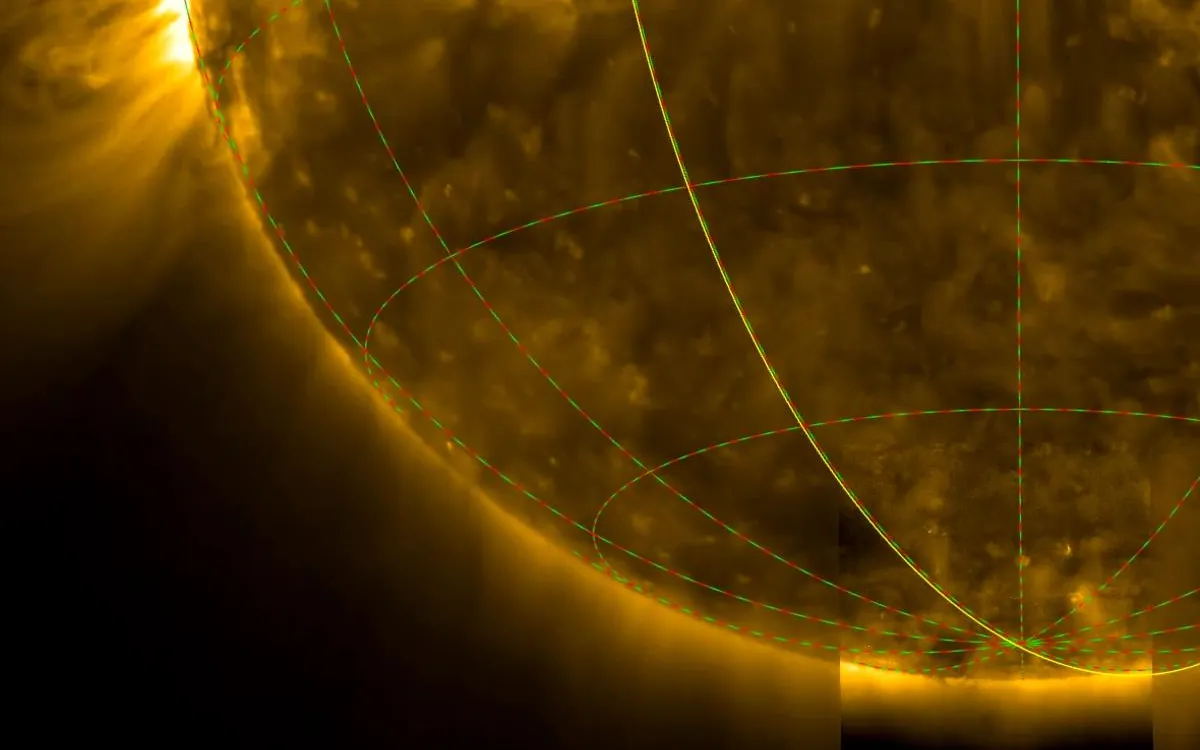
On March 23, 2025, the European Space Agency's Solar Orbiter spacecraft made history by becoming the first mission to capture images of the Sun's poles from outside the ecliptic plane. With its newly tilted orbit around the Sun, Solar Orbiter is set to revolutionize our understanding of the Sun's magnetic field, the solar cycle, and the dynamics of space weather. Historically, all images of the Sun have been taken from approximately its equator, as Earth, other planets, and operational spacecraft orbit the Sun within a flat disc known as the ecliptic plane. However, with its unique perspective, Solar Orbiter unveils the Sun from a groundbreaking angle.
The stunning collage from March 16-17, 2025, showcases the Sun’s south pole as seen from an angle of 15° below the solar equator. This marked Solar Orbiter’s first high-angle observation campaign, just days before reaching its maximum tilt of 17°. The images were captured using three of Solar Orbiter’s advanced scientific instruments: the Polarimetric and Helioseismic Imager (PHI), the Extreme Ultraviolet Imager (EUI), and the Spectral Imaging of the Coronal Environment (SPICE). These instruments provide complementary insights into the Sun's behavior and structure.
“We didn’t know what exactly to expect from these first observations – the Sun’s poles are literally terra incognita,” stated Prof. Sami Solanki, who leads the PHI instrument team at the Max Planck Institute for Solar System Research in Germany. Each instrument offers a unique observational capability: PHI captures images in visible light and maps the Sun's surface magnetic field, EUI reveals the million-degree charged gas in the Sun’s outer atmosphere (the corona), and SPICE analyzes light emitted from different layers of the Sun's atmosphere.
By synthesizing data from these three instruments, scientists can better understand the movement of materials within the Sun’s outer layers. This research may uncover unexpected patterns, such as polar vortices, which are swirling gases reminiscent of those found around the poles of Venus and Saturn. These groundbreaking observations are crucial for deciphering the Sun's complex magnetic field and understanding the solar cycle, which is characterized by magnetic field flips approximately every 11 years.
One of the initial findings from Solar Orbiter's polar observations revealed that the Sun's magnetic field at the south pole is currently chaotic. While a typical magnet has distinct north and south poles, the measurements from the PHI instrument indicate the presence of both polarities at the Sun’s south pole. This phenomenon occurs briefly during each solar cycle, particularly at solar maximum when solar activity peaks. After this field flip, a single polarity is expected to gradually dominate at the poles.
In approximately 5-6 years, the Sun is projected to reach its next solar minimum, a phase characterized by a more organized magnetic field and reduced solar activity. “How exactly this build-up occurs is still not fully understood, so Solar Orbiter has reached high latitudes at just the right time to follow the whole process from its unique and advantageous perspective,” noted Solanki.
Another significant advancement from the Solar Orbiter mission comes from the SPICE instrument, which has successfully conducted Doppler measurements for the first time. By tracking spectral lines emitted by various chemical elements such as hydrogen, carbon, oxygen, neon, and magnesium, SPICE can measure the velocity of clumps of solar material. This capability is vital for understanding how solar wind is generated—a primary goal of the Solar Orbiter mission.
“Doppler measurements of solar wind from past missions have been hampered by the limited view of the solar poles. Measurements from high latitudes, now possible with Solar Orbiter, will revolutionize solar physics,” remarked SPICE team leader Frédéric Auchère from the University of Paris-Saclay.
These initial observations are just the beginning for Solar Orbiter. The complete dataset from its first full ‘pole-to-pole' flight past the Sun is anticipated to arrive on Earth by October 2025. All ten of Solar Orbiter’s scientific instruments will continue to gather unprecedented data in the coming years. “This is merely the first step of Solar Orbiter's 'stairway to heaven': in the coming years, the spacecraft will ascend further out of the ecliptic plane for even better views of the Sun's polar regions,” explained Daniel Müller, ESA’s Solar Orbiter project scientist.
Solar Orbiter represents a groundbreaking international collaboration between ESA and NASA, marking the most sophisticated scientific laboratory ever dedicated to studying our life-sustaining star. By observing the Sun from a unique tilt, Solar Orbiter is set to enhance our understanding of the solar magnetic field, solar wind, and overall solar activity. As the mission continues, it promises to unlock new insights into the complexities of our nearest star, underscoring the importance of solar science for predicting space weather and protecting modern technologies.